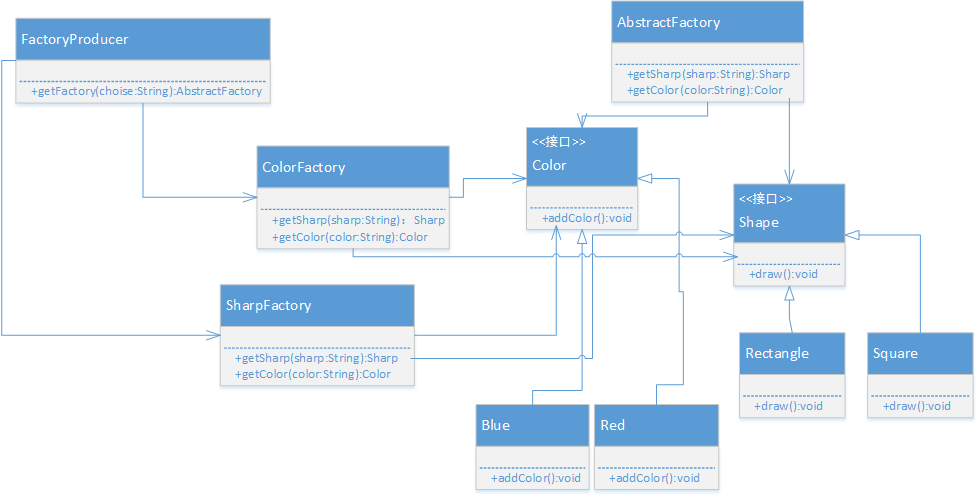抽象工厂模式
抽象工厂模式:
抽象工厂模式是指当有多个抽象角色时,使用的一种工厂模式。通过一个工厂的生成器来创建所需要的工厂,再由对应的工厂创建对应的对象。缺点:当需要扩展时,需要在原先的代码上进行扩展,容易把原先的代码误操作改掉。
1 //为颜色创建接口 2 public interface Color { 3 public abstract void addColor(); 4 }
1 public class Red implements Color { 2 @Override 3 public void addColor() { 4 System.out.println("Red::addColor() method"); 5 } 6 }
1 public class Blue implements Color{ 2 @Override 3 public void addColor() { 4 System.out.println("Blue::addColor() method"); 5 } 6 7 }
1 //为形状创建接口 2 public interface Shape { 3 public abstract void draw(); 4 }
1 public class Square implements Shape{ 2 @Override 3 public void draw() { 4 System.out.println("Square::draw() method"); 5 } 6 7 }
1 public class Rectangle implements Shape { 2 @Override 3 public void draw() { 4 System.out.println("Rectangle::draw() method"); 5 } 6 7 }
1 //为Color和Shape对象创建抽象类类获取工厂 2 public abstract class AbstractFactory { 3 public abstract Color getColor(String color); 4 public abstract Shape getShape(String sharp); 5 }
1 //颜色的工厂 2 public class ColorFactory extends AbstractFactory { 3 @Override 4 public Color getColor(String color) { 5 if (color == null) { 6 return null; 7 } 8 if (color.equalsIgnoreCase("RED")) { 9 return new Red(); 10 } else if (color.equalsIgnoreCase("BLUE")) { 11 return new Blue(); 12 } 13 return null; 14 } 15 16 @Override 17 public Shape getShape(String sharp) { 18 // TODO Auto-generated method stub 19 return null; 20 } 21 }
1 //形状的工厂 2 public class ShapeFactory extends AbstractFactory { 3 @Override 4 public Shape getShape(String shapeType) { 5 if (shapeType == null) { 6 return null; 7 } else if (shapeType.equalsIgnoreCase("RECTANGLE")) { 8 return new Rectangle(); 9 } else if (shapeType.equalsIgnoreCase("SQUARE")) { 10 return new Square(); 11 } 12 return null; 13 } 14 15 @Override 16 public Color getColor(String color) { 17 return null; 18 } 19 }
1 //创建一个工厂创造器/生成器类,通过传递形状或颜色信息来获取工厂。 2 public class FactoryProducer { 3 public static AbstractFactory getFactory(String choice){ 4 if(choice.equalsIgnoreCase("SHAPE")){ 5 return new ShapeFactory(); 6 } else if(choice.equalsIgnoreCase("COLOR")){ 7 return new ColorFactory(); 8 } 9 return null; 10 } 11 }
测试类:
1 //测试类 2 //使用 FactoryProducer 来获取 AbstractFactory,通过传递类型信息来获取实体类的对象 3 public class AbstractFactoryPatternDemo { 4 public static void main(String[] args) { 5 6 // 获取形状工厂 7 AbstractFactory shapeFactory = FactoryProducer.getFactory("SHAPE"); 8 9 // 获取形状为 Rectangle 的对象 10 Shape shape2 = (Shape) shapeFactory.getShape("RECTANGLE"); 11 12 // 调用 Rectangle 的 draw 方法 13 shape2.draw(); 14 15 // 获取形状为 Square 的对象 16 Shape shape3 = (Shape) shapeFactory.getShape("SQUARE"); 17 18 // 调用 Square 的 draw 方法 19 shape3.draw(); 20 21 // 获取颜色工厂 22 AbstractFactory colorFactory = FactoryProducer.getFactory("COLOR"); 23 24 // 获取颜色为 Red 的对象 25 Color color1 = colorFactory.getColor("RED"); 26 27 // 调用 Red 的 fill 方法 28 color1.addColor(); 29 30 31 // 获取颜色为 Blue 的对象 32 Color color3 = colorFactory.getColor("BLUE"); 33 34 // 调用 Blue 的 fill 方法 35 color3.addColor(); 36 } 37 }
运行结果:
Rectangle::draw() method
Square::draw() method
Red::addColor() method
Blue::addColor() method
UML图:

。
不能只满足于写完代码运行结果正确就完事,时常考虑如何让代码更加简练更加容易维护、容易扩展和复用,只有这样才可以真正得到提高
--《来自大话设计模式》



